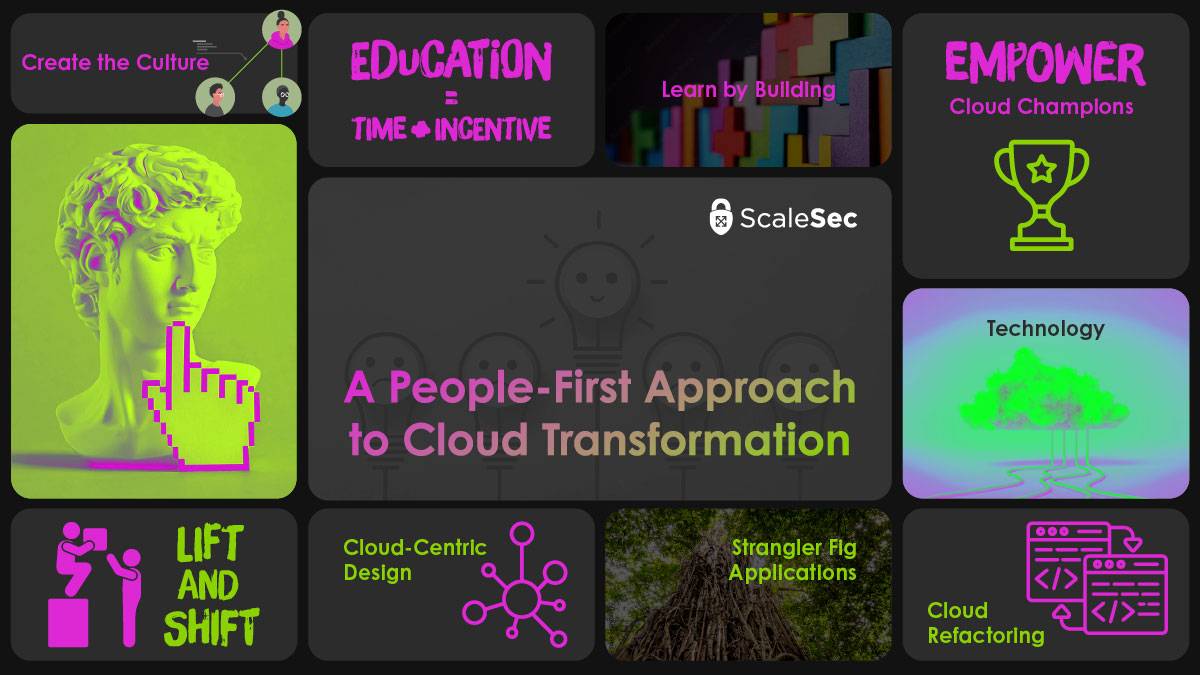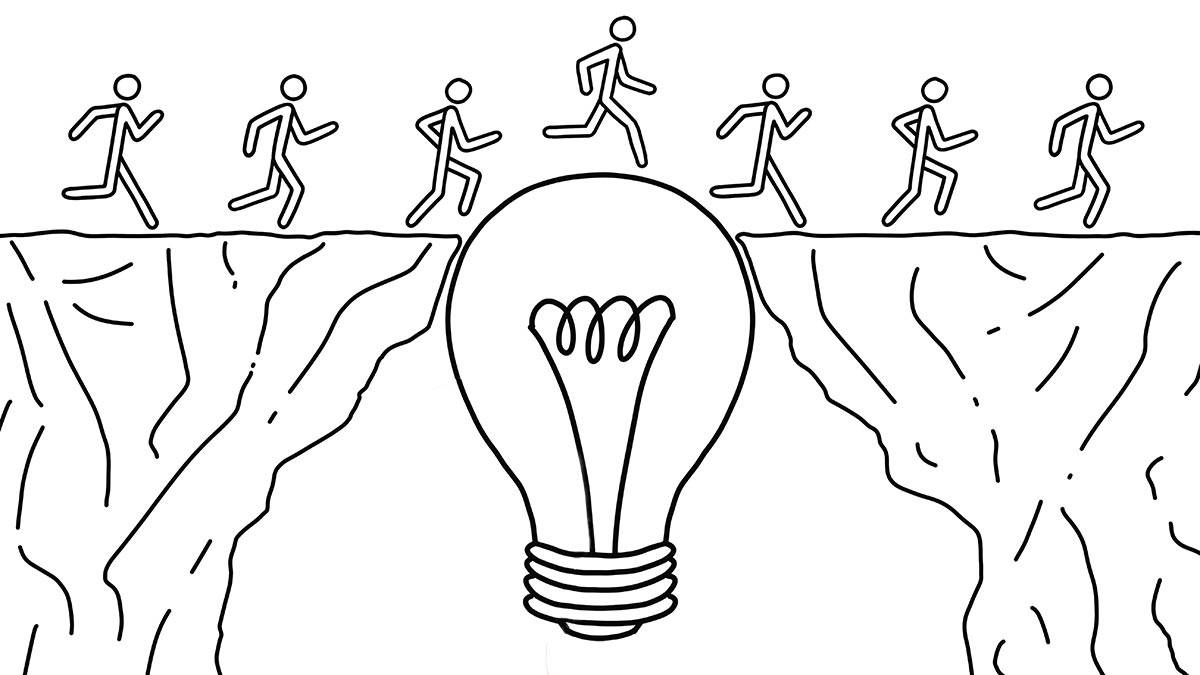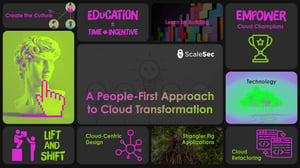
A People-First Approach to Cloud Transformation
Will they Resist, Accept, or Embrace?
When most people hear “cloud transformation,” it likely brings to mind only the technology involved. Technology changes are inherent to the process, but there is so much more that goes into it. Where do you start?
When beginning your cloud transformation there are two key areas of focus: culture and technology. Without the right culture, your journey to the cloud could be chaotic and difficult. Lack of understanding and a fear of change from your teams can prevent progress. Without the right technology, your culture won’t flourish and your efforts won’t be impactful. Striking the right balance enables swift innovation.

Without the right culture, your journey to the cloud could be chaotic and difficult
Company Culture
Keeping up with the current speed of innovation expected of a business is near impossible without embracing cloud technologies and the success of your cloud adoption relies on your people. Creating the appropriate culture to pivot into the cloud can be difficult. How can you accelerate your transition and improve your people’s experience at the same time?
True transformation starts from the top down. To be successful, leadership buy-in is imperative. The best way to accomplish this is to clearly and consistently communicate how this transformation will help each team make progress towards their own goals.
Accomplishing this will look different for every company and every team. Remember that not everyone has the same level of technical expertise. Explain the advantages of your initiative in a way that resonates with stakeholders. In an ideal world, developers and engineers will appreciate the improved speed of innovation, the finance team will value the cost breakdown visibility, and security teams will value the ability to shift some responsibility to a cloud provider, allowing them to focus their efforts. However, depending on your current culture, you may have to spend more time and effort showing the value and opportunities that this transformation can provide. Don’t give up!
Appreciate the value
Now that you have leadership buy-in, what’s next?
More often than not, companies that are beginning their cloud transformation don’t have deep knowledge of the cloud. Cloud technologies should not be handled in the same manner as on-premise technology. To bridge this gap, provide your technology teams with the support and encouragement needed to gain these skills. Start with the basics for everyone and work your way up. Align education goals to current projects and roles that employees already have. Be sure to provide time and incentive for learning! Don’t expect excitement or rapid change if you require your employees to spend their free time learning new technologies.

Bridge the gap
The best way to learn is by building. Provide each specialized team or member with a project that relates to their day-to-day job. This will allow them to see how the cloud works, get hands-on practice and provide value to the business along the way. The beauty of cloud technology is the rate at which iteration can occur. You can always continue to build out these initial projects as knowledge increases.
During this process, employees typically fall into one of three groups:
- Traditionalists: These are the technologists that have been around a long time and are hesitant to make changes. It can be tough going from an expert to a beginner again. Much of the hesitation here can be attributed to fear.
- Middle Ground: Here we find individuals that have no real objections, but aren’t going to go out of their way to lead the way toward transformation.
- Cloud Champions: This is where you will find your culture changers and future leaders. Cloud champions will jump in with both feet and work to bring others with them. They are passionate about the cloud and the capabilities it provides.
Know where your technologists stand and recognize that these categories are fluid. Don’t give up on the traditionalists! Instead, spend the time to learn what their hesitations are and do your best to provide reassurance and understanding. Find ways to show them, and the whole team, that their current skill sets are useful and encourage them to foster new ones. Encourage questions and be transparent. These actions can lead to light bulb moments for your technologists. Occasionally, a traditionalist can become your most fervent cloud supporter.
Empower cloud champions to lead the charge. Usually, this will happen naturally, but don’t neglect to show them your appreciation and provide them with opportunities to shine. Since they are genuinely excited about the new opportunities that cloud brings, they want to share their knowledge with others. Given the chance, this can light a spark of enthusiasm throughout the whole team.
The way leadership supports and interacts with their teams during this time will be one of the biggest indicators of how successful your transformation will be.
Leaders that appeal to their teams on an emotional level are 260 percent more likely to have a successful transformation.1 Never forget the power and importance of how you treat your people!

Positive emotion
Technology
Cloud adoption patterns can be used to guide your team through the technical process of cloud transformation. There are many ways to move an application to the cloud. What may be right for one, might not be for another. It’s important to take time to understand the benefits and pitfalls of each approach. An understanding of the inner workings of the application that is being moved to the cloud can help to make the right decision. Here is a brief look at a few of the most common adoption patterns.
Cloud Refactoring
Refactoring is the process of taking your current applications and changing them to better function in the cloud. This usually includes rearchitecting your current software or code base to take advantage of the flexibility and elasticity that the cloud offers.
Pros
- Resiliency Applications that are re-architected specifically for the cloud can be built with resiliency in mind. This helps with business continuity planning and allows for outages without any negative repercussions.
- Cost Savings: The “pay for use” model is one of the top benefits of using the cloud. If an application is architected with this in mind, it can scale in a way that on-premise technology cannot. Paying for computing power that you don’t use can be a thing of the past.
- Iteration Speed: Adding new features to applications built for the cloud is simpler. This allows developers to create more efficiently, making updates to your applications faster. In addition, moving to the cloud can reduce the time spent on maintenance and monitoring of infrastructure. Teams are then able to spend more time creating.
Cons
- Time-Consuming: Re-architecting a legacy application can be arduous. Every application is created differently and the ins and outs of it must be discovered before re-architecting can begin.
- Skill Gaps: Cloud knowledge is the basis for this transformation. Taking something that already exists and refactoring it into the cloud will require someone familiar with both the cloud and the current application, which can be hard to find.
- Breaking Changes: Many changes will be made during the refactoring process. What worked on-premise, may not work in the cloud. Along the way, there will be things that don’t work and it’s important to know how those will affect your business.
Strangler Fig Application
This approach takes a legacy system and utilizes its functional entry points to redirect to new systems as they are built. Over time, updated systems will be the default, and the old system can be “strangled” or decommissioned in favor of the newly built cloud systems.
Pros
- Reduced Risk: There is no action taken to change the current application, which means that it will always be in the same state it was in before you redirected a portion of it to the cloud. This allows for an easier fix if something goes wrong.
- Utilizes existing technology: This strategy allows you to slowly shift your application to the cloud while continuing to make use of current on-premise technology. If you aren’t able to completely cut ties with on-premise systems, this is a good way to split the difference.
Cons
- Rollback Requirement: Knowing how to quickly and safely roll back a redirect that went wrong is a must. If unfamiliar with the application or the cloud, this could pose a problem.
- Upkeep Efforts: The old application pieces will still be in play. This strategy requires the upkeep of the legacy application, creating tech debt that can be difficult to solve. Additionally, an awareness of which entry point directs to where and how the network and endpoints are configured is required. If dealing with a large application that contains hundreds of entry points, this can be overwhelming.
Cloud-Centric Design
When starting a new application, it’s best to use cloud best practices from the beginning. The cloud-centric architecture will utilize microservices and domain-driven design to take advantage of all the cloud has to offer.
Pros
- Elasticity: When used as intended, systems built in the cloud are easily able to scale. This allows for cost-effective and flexible architectures that cannot be achieved with on-premise technologies.
- Optimization: Starting an application in the cloud allows optimization from the start. Create the application to be cost-effective and resilient. Improvements will be easier to make going forward since it will already be architected for the cloud.
Cons
- Knowledge Gaps: Knowing how to architect for the cloud is different from architecting for on-premise. Lack of experience can diminish the impact cloud computing may have on business continuity and cost savings.
Lift and Shift
A lift and shift approach can be taken to move applications to the cloud without any redesign or changes to your workloads. There are many scenarios that this approach may be a good fit, such as needing to exit a data center lease without renewing. However, this type of architecture should not be your end goal. It’s imperative that you still plan and execute application refactoring to take full advantage of cloud services and ephemeral functionality.
Pros
- Low Initial Effort: As this approach effectively re-creates the on-premise architecture that you are already using, no redesign or changes are required. This may be good for teams that are more familiar with traditional technologies. This minimal-effort undertaking can be a great gateway to cloud computing, so long as there is a strong plan in place to refactor the application as soon as possible.
Cons
- Lack of Optimization: When architected properly, applications in the cloud are meant to be elastic, resilient, and flexible. Simply rehosting a traditional architecture in the cloud does not provide any of these advantages. Old business practices are likely to follow that could ultimately cost more to run in the cloud than on-premise.
Summary
A successful transformation requires support, collaboration, and strategy. All of which is accomplished by your people. Creating a culture that embraces these values is the only way to truly succeed in your cloud journey. Regardless of what technology or adoption strategy you choose, always remember that people are the lynchpin to a successful transformation. ScaleSec has proven methods to assist companies in their cloud transformation journey. If you feel that you could use additional guidance, reach out!
